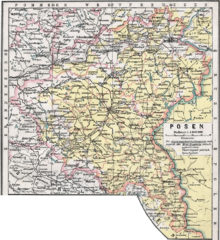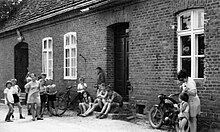Kępa (Trzcianka)



Kępa ( German cap ) is a village in the Greater Poland Voivodeship in Poland and belongs to the Trzcianka municipality . It is located about 12 km northeast of the main town Trzcianka and about 80 km north of Poznan .
About history and culture
Cap is located southwest of Schneidemühl in the triangle between the places Schönlanke , Niekosken and Stöwen . It has historically developed as a typical farming village in West Prussia and had 255 German residents before the Second World War. The village has achieved a prominent importance through its facilities of the infrastructure , which reached beyond the village boundaries. One were among this infrastructure school that was set up as Einklassenschule as was customary on the sprawling country, a church for Protestant and Catholic Christians, a shop and a bakery , a post office , several artisans such as carpenters , a wheelwright , blacksmith , shoemaker , butcher and also a shepherd and an innkeeper . The community had a connection to the electricity network via overhead lines, so that the operation of electrical lighting and electric motors as well as, in particular, radio reception were possible. The water supply was secured on each property via its own well with a hand pump . Wood-heated (tiled) stoves were used for cooking and to provide heat in the houses . Most of the farms also had their own oven for baking bread and cakes. For the preservation of meat products such as sausage and ham, smoking chambers or barrels were used for curing meat.
In addition to the actual village center with its village square , on which the individual streets converged in a star shape, and its village pond as a fire water reservoir, several individual farms were included as so-called “dismantling”. Agriculture and cattle breeding took place in family farms on their own farms, which were located directly behind the respective houses. The agriculture was traditionally performed with horses served as draft animals for transport and soil cultivation (tractors and cars were not in use), while the sowing, mowing and harvesting largely manual labor was. Mechanization with a seed drill, mower and threshing machine with electric drive as well as the associated new barn building could only afford one single farming family because their son Walter Kuno Kriesel (1906–1945) gained the necessary experience from his 2-year work stay in the USA in the early 1930s and brought the necessary amount of dollars. Walter Kuno Kriesel brought with him further experience abroad for the village of cap from a lengthy stay in Italy , which had taken him to Palermo in Sicily .
The Gutshof Hütte (Rudka in Polish) was also within sight of the village ofkap , where, in addition to arable farming and cattle breeding in the large-scale farming style, the products were also processed in their own dairy and distillery .
The larger towns in the area around Cap were Schönlanke , the district town Deutsch Krone and the free district town Schneidemühl (administrative region Grenzmark Posen-West Prussia). The next railway stations were the railway stations in Stöwen (Polish Stobno, 7 km away, part of the community calico ) and Schönlanke (km 12), both of which already in 1851 by King Frederick William IV. , Opened Prussian Eastern Railway as a major route between Schneidemühl via Küstrin ad Oder to Berlin (originally Old East Station Berlin , later Berlin Schlesischer Bahnhof ; Berlin Ostbahnhof ).
During the Second World War , all of the men who were fit for military service were gradually drafted into military service, so that there were considerable gaps in the main workforce, which were made up by Polish workers. The acts of war itself only became noticeable inkap when the evacuation order was issued for this location around January 25, 1945 .
A trek with horse-drawn carts, on which the women, children and old men and their belongings were housed, headed west, but was stopped by the Red Army in the nearby town of Schrotz . Due to heavy snowfall, the escape could not be continued, and the return to Cap was only possible as far as the neighboring village of Kegelsmühl , 2 km before , where a 4-week forced stay in a communal accommodation followed.
The farmer and horse breeder Reinhard Kriesel (1876–1958) succeeded in presenting his special knowledge of horses to the Soviet commander at the "Hütte" estate, who commanded a mounted Ukrainian army unit with around 50 horses and spoke perfect German, and at the same time made everyone return to obtain remaining villagers after cap. This courageous action by Reinhard Kriesel was not without danger because it took place at the end of February 1945 andkap was still on the edge of the combat zone; he was voluntarily accompanied by his grandson Konrad Schmidt (1935-2016), who was only 9 years and 5 months old at the time. After their return, all the villagers had to work on the farm for the Red Army’s food supplies. These people in cap lived completely cut off from the outside world for the whole of 1945, there was no electricity, so neither lighting nor radio, but also no newspapers, only the end of the war on May 8, 1945 was the victory celebration of the Red Army on the manor apparently on May 9, 1945.
Shortly before Christmas 1945, the commander announced the withdrawal of his troops to the Soviet Union, and the area was then administered in Polish. With the support of the new Polish estate manager, all the remaining residents were able to leave their home village of Cap via the Stöwen station with a completely overcrowded train and finally to flee westwards in a second escape.In the completely destroyed Küstrin they walked on an auxiliary bridge over the Oder to a safe area on Reach Berlin on Christmas Eve 1945, which was bombed and shot, but now a bit tidy , and mostly stay with relatives and friends.
A part-time mayor was responsible for the administration of the public affairs of Cap . His duties were last carried out by the 70-year-old Adolf Kriesel (around 1873-1960) until the German population had completely left the village at the end of 1945.
In the course of the massive resettlement campaigns at the end of the war in 1945, the former residents of Cap and their descendants were largely scattered across the area north of the Berlin-Hanover line and in central Germany: Berlin, Espelkamp-Mittwald, Hamburg, Eddelak, Heikendorf near Kiel, Forkenbeck near Rostock , Demmin, Spantekow near Anklam and Alsleben / Saale, Leipzig to Grünwald / Munich, so that the German village association cap has completely disintegrated.
The parish cap
In the early 1930s, the municipality of cap was a rural municipality in the Deutsch Krone district in the Grenzmark province of Posen-West Prussia . With the administrative reform of October 1938, the Deutsch Krone district and with it the municipality of cap came to the province of Pomerania . The municipality of cap was a regional authority with an area of 9.7 km². There were 5 places of residence within the municipal boundaries, of which the main place of residence was cape for this rural municipality:
- Good luck for
- Junkermühl
- cap
- Kleinmühl
- Krummfließerhütte.
At that time there were a total of 44 inhabited houses as well as the associated stables and barns at all 5 residential areas of the community.
Population of the municipality of cap
In 1925, the municipality of cap had a resident population of 356 inhabitants, of whom 172 were male (48.3%) and 184 female (51.7%). Thus, an average of 8.1 inhabitants per house or 36.7 inhabitants lived on one km². The population in the municipality of cap lived in 69 households (5.2 inhabitants in the household or 1.6 households per house). The registry office was in Krummfliess .
With 313 Protestants (87.9%) in 1925, the vast majority of the inhabitants in the community of Cap were evangelical, there were still 35 Catholics (9.8%). The Protestant residents of the parish cap belonged to the parish of Groß Wittenberg (ev. Pastor 1936–1945: Erwin white ), the catholic parish was in Rose .
Administration of the municipality of cap
A rural municipality was a local authority at the lowest administrative level. The community administration was headed by a community leader elected for 6 years, who had been designated mayor since the 1930s . There was also a local council . The head of the district of Krummfließ was responsible for the local police in the municipality of cap. The land registry office was responsible for property matters, the tax office for taxes and the district court in Deutsch Krone for jurisdiction, the trade supervisory office was also here. The responsible Chamber of Agriculture , the Chamber of Crafts and the Chamber of Industry and Commerce were in Schneidemühl. The responsible mining authority was in Breslau .
Kępa as part of Gmina Trzcianka
Since 1946, the resettlement of cap and hut has been carried out by Polish residents, who in turn also came as resettlers from the former Polish eastern regions, which were separated from Poland and added to the Soviet Union. The village of Kępa is now administered from the Town Hall of the City and Rural Municipality (Gmina) Trzcianka , which covers an area with 24,000 inhabitants. Gmina Trzcianka includes - in addition to the city of Trzcianka - another 36 villages. Its area lies between the border with the West Pomeranian Voivodeship in the northwest and the Netze River in the southeast. Neighboring municipalities to Gmina Trzcianka are:
- Czarnków ( Czarnikau ) and Wieleń ( Filehne ) in the powiat Czarnkowsko-Trzcianecki ,
- Szydłowo ( Groß Wittenberg ) and Ujście ( (German) Usch ) in the Powiat Pilski ( Schneidemühl district ), as well
- Człopa ( Schloppe ) and Wałcz ( Deutsch Krone ) in the powiat Wałecki ( Deutsch Krone district ), already located in the West Pomeranian Voivodeship .
Personalities of the rural community
Konrad Schmidt (1935–2016), German graduate in administration; Senior Post Councilor at the Oberpostdirektion Kiel; Managing Director for Human Resources at Telekom Immobilien GmbH Kiel (born in Schneidemühl, lived in cap from 1935 to 1939 and from Jan. to Dec. 1945, in between in Ludom / Ludomy)
Werner Kriesel (* 1941), German professor for automation and communication (born inkap, lived here until December 1945)
Web links
- Description of the town of Schönlanke
- Gunthard Stübs and Pommersche Forschungsgemeinschaft: The community of cap in the former district of Deutsch Krone in Pomerania (2011).
Individual evidence
- ↑ Central Statistical Office (GUS) - TERYT (National Register of Territorial Land Apportionment Journal) ( Polish ) June 1, 2008.
- ^ Konrad Schmidt: From Schneidemühl via Ludomy to St. Peter-Ording. In: Dune sand & North Sea beach. Winterwork printing company, Borsdorf near Leipzig 2009, customer no. 07373, order no. AU14-0833, page 29.
- ^ Konrad Schmidt: From Schneidemühl via Ludomy to St. Peter-Ording. In: Dune sand & North Sea beach. Winterwork printing company, Borsdorf near Leipzig 2009, customer no. 07373, order no. AU14-0833, page 33.
- ↑ Gunthard Stübs: The community of cap in the former Deutsch Krone district in Pomerania. Berlin 2011, Internet: “Pomeranian Research Association” in the “Pomeranian Information System”.
- ^ Community encyclopedia for the Free State of Prussia. Grenzmark Province of Posen-West Prussia. According to the final result of the census of June 16, 1925 and other official sources based on the territorial status of December 1, 1930. Prussian State Statistical Office, Berlin 1930, p. 4 (quoted from Gunthard Stübs, Berlin 2011, Internet: "Pommersche Forschungsgemeinschaft" in the "Information System Pomerania").
- ↑ Gunthard Stübs: The community of cap in the former Deutsch Krone district in Pomerania. Berlin 2011, Internet: “Pomeranian Research Association” in the “Pomeranian Information System”.









